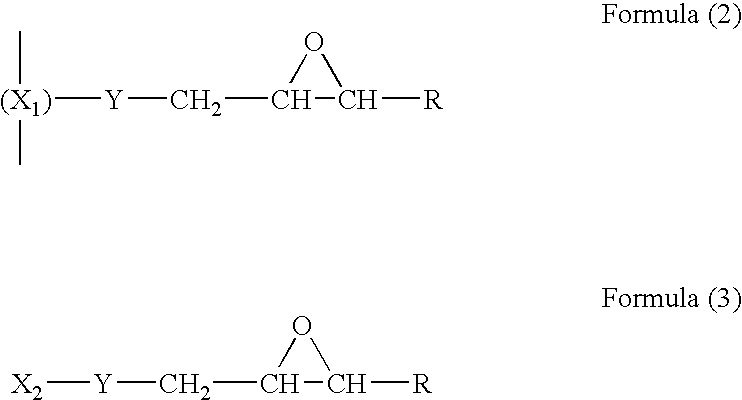Electrolyte compositions
a technology of electrolyte composition and composition, which is applied in the field of electrolyte composition, can solve the problems of high possibility of intermolecular crosslinking reaction between diol and triphosgene, and achieve the effect of easy and quantitative introduction
- Summary
- Abstract
- Description
- Claims
- Application Information
AI Technical Summary
Benefits of technology
Problems solved by technology
Method used
Image
Examples
example 1
(Synthesis Example) (Synthesis of Polymers-1 Containing Cyclocarbonato Groups)
(1) Synthesis of Polymer (A-1)
[0071]A polymerization reaction vessel was fitted with a reflux condenser, a thermometer, a stirrer and a nitrogen gas inlet tube. Dimethylformamide (DMF) (200 g), glycidyl methacrylate (GMA) (50 g) and as a polymerization initiator, azobisisobutyronitrile (AIBN) (1.5 g) were charged and, while nitrogen gas was caused to flow through the polymerization reaction vessel, a polymerization reaction was conducted at 80° C. for 6 hours to yield polyglycidyl methacrylate (PGMA). Into a reaction vessel equipped with a reflux condenser, a thermometer, a stirrer and a carbon dioxide inlet tube, a solution (100 g) of PGMA (20 g) in DMF and lithium bromide (LiBr) (1.22 g) were charged and, while carbon dioxide was blown at a flow rate of 5.0 liters per minute, a reaction was allowed to proceed at 100° C. for 2 hours. The resulting, pale yellow, clear polymer solution was added dropwise in...
example 2
(Synthesis Example) (Synthesis of Polymers-2 Containing Cyclocarbonato Groups)
(1) Synthesis of Copolymer (A-1)
[0073]In a similar manner as in Example 1, DMF (210 g), GMA (50 g, 0.35 mol), 2-hydroxyethyl methacrylate (HEMA) (0.91 g, 0.007 mol) and AIBN (1.5 g) were charged into a polymerization reaction vessel, and a polymerization reaction was conducted to yield a GMA / HEMA copolymer containing hydroxyl groups. In a similar manner as in Example 1, carbon dioxide was then blown in in the presence of lithium bromide as a catalyst to conduct cyclocarbonation. Precipitation, filtration and drying were conducted to obtain a pale yellow polymer. This CCPMA-HEMA copolymer will be referred to as “Polymer-2 containing cyclocarbonato groups”. LiClO4 was added in proportions of from 50 to 80 mol % based on the cyclocarbonato groups in Polymer-2 to afford electrolyte compositions according to the present invention. The ion conductivites of those electrolyte compositions were determined to range ...
example 3
(Synthesis Example) (Synthesis of Polymers-3 Containing Cyclocarbonato Groups)
(1) Synthesis of Copolymer (A-1)
[0075]In a similar manner as in Example 1, DMF (210 g), GMA (50 g, 0.35 mol), polyethylene glycol monomethacrylate (PEGMA) (51 g, 0.12 mol), HEMA (3.0 g, 0.02 mol) and AIBN (1.5 g) were charged into a polymerization reaction vessel, and a polymerization reaction was conducted. In a similar manner as in Example 1, carbon dioxide was then blown in in the presence of lithium bromide as a catalyst to conduct cyclocarbonation. Precipitation, filtration and drying were conducted to obtain a pale yellow polymer. This CCMA-PEGMA-HEMA copolymer containing hydroxyl groups will be referred to as “Polymer-3 containing cyclocarbonato groups”. LiClO4 was added in proportions of from 50 to 80 mol % based on the cyclocarbonato groups and ether groups in Polymer-3 to afford electrolyte compositions according to the present invention. The ion conductivites of those electrolyte compositions we...
PUM
| Property | Measurement | Unit |
|---|---|---|
| temperature | aaaaa | aaaaa |
| mol % | aaaaa | aaaaa |
| chemical shifts | aaaaa | aaaaa |
Abstract
Description
Claims
Application Information
 Login to View More
Login to View More - R&D
- Intellectual Property
- Life Sciences
- Materials
- Tech Scout
- Unparalleled Data Quality
- Higher Quality Content
- 60% Fewer Hallucinations
Browse by: Latest US Patents, China's latest patents, Technical Efficacy Thesaurus, Application Domain, Technology Topic, Popular Technical Reports.
© 2025 PatSnap. All rights reserved.Legal|Privacy policy|Modern Slavery Act Transparency Statement|Sitemap|About US| Contact US: help@patsnap.com



